- Proper Clothing
- PTO Safety Tips
- Tractor
- Emergency Preparedness
- Highway Transportation
- Field Operations
- Fire
- Grain Bins
- Livestock Handling (Cattle)
- Web Link Resources
An ounce of prevention is worth a pound of cure. Most farm injuries and fatalities are preventable when you adhere to safe operating practices. The following are general guidelines for improved safety on the farm. Web resources for further recommendations and information are provided.
Proper Clothing
Loose clothing is a common cause of injury in agriculture. Most agricultural equipment has gears, pulleys and sharp edges that can easily catch clothing. As a precaution, wear tight fitting clothing; keep cuffs buttoned and shirts tucked in; don’t wear a tie while working and remove any loose jewelry. Keep long hair under a cap or head covering to prevent it from getting tangled in equipment. Wearing a broad-brimmed hat is also recommended to reduce sun exposure, a leading cause of skin cancer to farmers.
PTO Safety Tips
Power take-off (PTO) drives are extremely dangerous. Today’s equipment must come with appropriate guarding to keep moving parts shielded. Older machines, however, are normally not guarded and many of the guards on the newer machines are bent, broken or have been removed.
While the following tips sound obvious, they are good reminders.
- NEVER step over a PTO shaft.
- ALWAYS replace PTO guards when they are not properly covering the shaft and u-joints.
- ALWAYS disengage the PTO, turn the tractor off and remove the key before leaving the tractor seat.
- ALWAYS connect the PTO guard on the driveline to a stationary point on the tractor. This prevents the guard from rotating with the shaft.
- NEVER grip a PTO guard while the shaft is turning. Dirt, ice or rocks can get between the guard and shaft, causing the guard to turn and making it a hazard. Before connecting the driveline check to see that the guard turns easily around the driveline.
- Keep Children away from the PTO and the equipment it is powering.
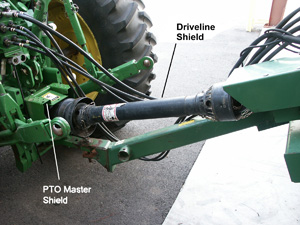 PTO driveline safety cover: All rotating parts are covered and the cover does not rotate.
PTO driveline safety cover: All rotating parts are covered and the cover does not rotate.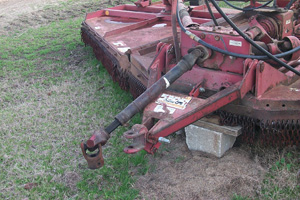 PTO driveline without safety guards.
PTO driveline without safety guards.
Tractor
One of the greatest threats to an operator from the tractor itself is rollover. New tractors must have rollover protective structures (ROPS), and many older tractors have been retrofitted. A serious danger from rollover of open cab tractors exists, however, when a seat belt is not being worn. The ROPS provides a protective space to prevent you from being crushed by the tractor. Without your safety belt, you can easily fall out of the seat and still get crushed by the tractor. You may even be crushed by the ROPS — the very piece of safety equipment provided to save you in a rollover. The following are general guidelines to ensure safe operation of your equipment:
- Always hitch to the rear hitch points on a tractor and be extremely careful on inclined surfaces. The most common causes of rollover are operating on a steep incline and hitching to the rear of the tractor at the wrong hitch point.
- DO NOT allow extra riders. Children and adults have been killed falling off tractors.
- Make sure everyone has had proper training when operating a piece of machinery. Many people are afraid to ask for training, even when they need it. As a precaution, give new employees training and a period of observation to help them if needed. Also, realize that teenagers do not have the judgment skills gained from experience adults have. Although they may be able to operate farm machinery, they should not go unsupervised for long periods of time.
- Do not by-pass start a tractor or other piece of equipment. When you bypass start a tractor, you are bypassing all the safety-start and neutral-start switches.
- Read all the operator manuals and become familiar with the equipment before operating.
- Always wear your safety belt in equipment that has a ROPS structure. Do not wear a safety belt if the equipment does not have a ROPS structure.
- Never dismount the tractor while the engine is running.
- Lower hydraulic equipment before dismounting or finishing for the day.
- Be aware of your surroundings. Watch for holes, ditches, narrow bridges, and for others that may be working around the equipment.
- Conduct a pre-operational safety check each time the equipment is used. Check fluids, tire pressure, brakes and lights. Make sure gauges are at their proper readings.
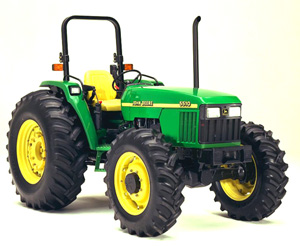 ROPS equipped tractor.
ROPS equipped tractor.Emergency Preparedness
Every member of a farm family and their hired workers (for farms with large numbers of migrant workers, the foremen) should be trained in life-saving techniques, including first aid and CPR. In rural areas where medical help may be several minutes away, the first person on the scene may need to initiate life-saving aid before emergency rescue personnel arrive.
- Make sure everyone knows where to make emergency phone calls and that emergency numbers are located on a laminated sheet next to the phone. If necessary, provide bilingual resources.
- Install an emergency information box. This box should contain a detailed map of the farm, emergency contact persons and phone numbers, locations, amounts and MSDS sheets of all chemicals stored on the farm, and a list of all the major contents of each building. This box should be well hidden and its location only known by the farm owner and local authorities (fire, EMT and police departments). Have the location entered into the local 911 center.
- Keep a well-stocked first aid kit. For recommendations about items in a first-aid kit, call your local Red Cross.
Highway Transportation
One of the most dangerous farming operations is driving or carrying equipment over state and county roads. Always use a slow moving vehicle (SMV) emblem when driving equipment on the highway. One of the most common causes of accidents on public roads is when motorists attempt to pass a SMV. In many cases, motorists will mistakenly believe the farm operator is turning right when he is actually swinging to the right to make a left turn. Motorists can mistake the initial right turn for an opportunity to pass on the left side and cause a collision. (See figure below.) Use pilot vehicles to alert motorists and keep them from getting too close, and use two-way radios to communicate with the pilot vehicle.
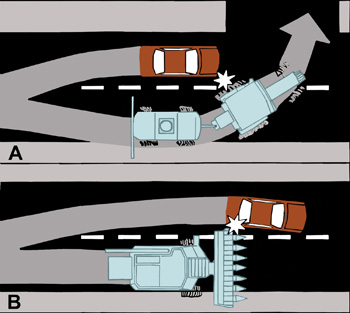
- If transporting equipment on a trailer, be very careful to fully secure the equipment and to adjust all vehicle mirrors so you have a clear view of traffic around you.
- If moving a cotton picker or module builder, be aware of the height of your machine. Make sure the basket/ packer is lowered. Several cases of downed power lines have occurred from the packer on the module builder being left in the retracted (up) position.
- When possible, travel during low traffic periods and when visibility is good.
- Lock the left and right brake pedal together to ensure that a sudden braking maneuver does not cause the tractor to veer left or right.
- Check the tractor to make sure all lights and turning signal equipment (when available) are operational. If no signaling equipment is available, use hand signals to warn traffic of your intentions (stopping, turning).
Field Operations
An injury that would not be considered life threatening near the shop can turn fatal in the field. Injuries that occur when the operator is in a field, alone, can leave the worker stranded for hours. As a precaution, always alert someone with a two-way radio or cell phone when you dismount a tractor or other piece of equipment. If you do not call back within 10 minutes, someone should call you. Also, make regular calls to let someone know where you are and that you are OK. Again, if you miss a regular call-in, someone should call to see that you are OK.
- Do not clear clogged equipment while it is running. Many injuries and fatalities occur when someone is caught in a running machine and cannot get out.
- Maintain field rows to reduce risks of rollover. Widen roads and bridges to maintain a safe secure roadway that will not collapse.
- Maintain adequate end-of-row turning space for safe turns.
- Control vegetation that can hide hazards (e.g. ditches, holes, rocks) and remove hazards when possible. When not possible, make sure hazards are clearly marked.
Fire
A few steps towards fire prevention and preparedness on the farm can reduce the potential of a fire and the extent of damage in case a fire does occur. The following tips are recommended:
- Keep ignition sources away from combustible material in and around your farm buildings. Keep flammable liquids in labeled safety containers and store in a flammable-liquid safety cabinet.
- Test fire and smoke alarm systems on a regular basis (at least once a year).
- Make sure electrical power requirements are met sufficiently without overloading your electrical system.
- Keep motor and machine tools free of dust and grease.
- Inspect wiring on electric motors and appliances.
- Select the proper fire extinguisher for the type fire that may occur. Inspect and service extinguishers at least once a year. Make sure everyone has read the instructions and understands how to use an extinguisher.
- Invite your local fire department to your farm to inspect the best access routes to buildings and sources of water for pumping. They can also conduct an inspection and give advice on reducing fire hazards.
Grain Bins
Several hazards are associated with handling grain in grain bins and you need to take precautions:
- Keep protective screens or covers on all grain augers. Also, do not reach into a grain auger while it is running.
- When moving a portable auger, look up to see if it is close to a power line. Many people are electrocuted by portable augers when they get entangled in power lines.
- Do not enter a grain bin when the grain is being removed.
- Do not enter a grain bin where grain has been removed. If a crust must be broken, do so from the roof with an extended pole.
- If you must enter a grain bin, make sure the unloading auger is shut off and locked out and that you have a reliable method of communication with someone on the outside of the bin. Use a rope and safety harness to avoid risking suffocation from collapsed grain. Never enter a grain bin alone.
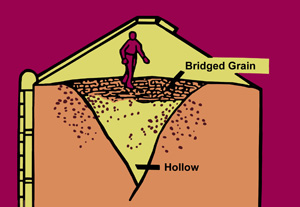 The danger of collapse from bridged grain.
The danger of collapse from bridged grain.Livestock Handling (Cattle)
Livestock are very dangerous if they are not respected.
Cattle Senses
Cattle have a wide angle of vision (almost 360 degrees) and are easily frightened by shadows, unfamiliar objects and loud noises. Cattle will move around to see what is in their blind spot and are more easily agitated when something remains there. Sound is also important to cattle. They are sensitive to loud and high pitched noises.
Herding
Cattle are herding animals and will be much easier to move when they are in contact with other cattle. They tend to follow the leader, so if you can get one to move in the desired direction, the others will follow.
Another behavioral concept that is important is the “flight zone.” Livestock will react in a variety of ways according to a handler’s activities relative to their flight zone. For example, livestock will face a handler and maintain a safe distance when the handler is outside their flight zone. In contrast, livestock will turn away from a handler who enters their flight zone. Individual animals will have flight zones of varying sizes based on their fright level. Working from the edge of the flight zone will generally help keep livestock calm and manageable.
The point of balance is another important behavioral principle to understand. An animal’s point of balance is located at its shoulders. An animal will move depending on the handler’s position relative to its point of balance. This principle can be used to calmly and easily encourage livestock through crowding pens, and squeeze chutes. For example, when a handler stands behind the animal’s point of balance, the animal will move forward. When the handler stands in front of an animal’s point of balance, the animal will stop or back up. To encourage an animal forward, simply walk toward the animal, crossing the point of balance, and it will move forward.
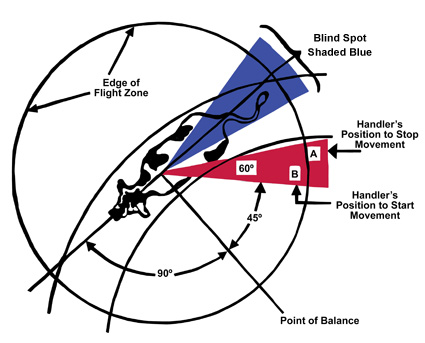
Corrals and Chutes
Sudden changes in a chute or corral, either visual or auditory, can frighten an animal. Remove noise makers such as loose chains or hanging pieces of metal. Also remove visual distractions and dark areas in the chute. Even a small piece of paper that may seem innocuous to us may be a large distraction and frighten livestock. Examine corral and chute layouts to reduce animal stress. A less stressful animal is less dangerous.
Livestock Handling Precautions
Some general precautions when handling livestock include:
- Be alert. It is impossible to fully know or predict animals’ actions. Always be aware of what is happening around you. This is particularly important when handling livestock at sunrise and sunset when livestock are most active.
- Carefully approach animals. Because of the placement of their eyes, cattle have approximately a 270-degree range of vision. Despite their range of vision, cattle have poor depth perception and are unable to see behind them. To reduce risk, always announce yourself when approaching an animal.
- Leave yourself an exit path. Never enter small enclosed areas with livestock. If unavoidable, always be sure you have a fast and easy escape route.
- Avoid quick movements and loud noises. Livestock can startle and frighten easily. Move slowly and deliberately around livestock. Be careful not to create excess noise.
- Be patient. When working with livestock in a crowding pen, chute or squeeze, prodding an animal when it has no place to go is dangerous. Animals can react quickly and violently.
- Always consider mature males and nursing females dangerous. Be aware of animals that are sick, injured or otherwise frightened.
- Train new workers and handlers before allowing them to work with livestock.
Web Link Resources
National Ag. Safety Database – Resource location of papers, video, and presentations in agricultural safety http://www.cdc.gov/nasd/
Animal Handling. Dr. Temple Grandin – Associate Professor of Animal Science, Colorado State University http://www.grandin.com
Youth in Agriculture http://www.osha.gov/SLTC/youth/agriculture
Southeast Center for Agricultural Health & Injury Prevention https://www.uky.edu/scahip/
Farm Safety 4 Just Kids http://www.fs4jk.org/
North American Guidelines for Children’s Agricultural Tasks http://www.nagcat.org/
National Children’s Center for Rural and Agricultural Health and Safety http://www.marshfieldresearch.org/nccrahs
University of Florida Ag Safety Website http://www.flagsafe.ufl.edu
1Assistant Professor, Biological and Agricultural Engineering, Tifton Campus
Status and Revision History
Published on Nov 04, 2004
Published on Feb 23, 2009
Published on May 14, 2009
Published with Full Review on May 25, 2012
Published with Full Review on Apr 11, 2017
